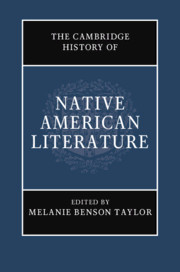Book contents
- The Cambridge History of Native American Literature
- The Cambridge History of Native American Literature
- Copyright page
- Contents
- Figures
- Contributors
- Introduction: What Was Native American Literature?
- Part I Traces and Removals (Pre-1870s)
- 1 Indigenous Languages and the Origins of American Literary History
- 2 Unsettling Colonial Temporalities: Oral Traditions and Indigenous Literature
- 3 Early Native American Literature and Hemispheric Studies
- 4 Performative Cultures of Early America
- 5 Nineteenth-Century American Indian Newspapers and the Construction of Sovereignty
- 6 Indigenous Literacies in Early New England
- Part II Assimilation and Modernity (1879–1967)
- Part III Native American Renaissance (Post-1960s)
- Part IV Visions and Revisions: 21st-Century Prospects
- Index
- References
1 - Indigenous Languages and the Origins of American Literary History
from Part I - Traces and Removals (Pre-1870s)
Published online by Cambridge University Press: 18 September 2020
- The Cambridge History of Native American Literature
- The Cambridge History of Native American Literature
- Copyright page
- Contents
- Figures
- Contributors
- Introduction: What Was Native American Literature?
- Part I Traces and Removals (Pre-1870s)
- 1 Indigenous Languages and the Origins of American Literary History
- 2 Unsettling Colonial Temporalities: Oral Traditions and Indigenous Literature
- 3 Early Native American Literature and Hemispheric Studies
- 4 Performative Cultures of Early America
- 5 Nineteenth-Century American Indian Newspapers and the Construction of Sovereignty
- 6 Indigenous Literacies in Early New England
- Part II Assimilation and Modernity (1879–1967)
- Part III Native American Renaissance (Post-1960s)
- Part IV Visions and Revisions: 21st-Century Prospects
- Index
- References
Summary
This chapter explores how European colonists in North America struggled to understand, translate, and interpret Native American languages by relying on indigenous interlocutors. European missionaries and indigenous people co-authored an extensive archive of texts in Wampanoag, Mi’kmaq, Mohawk, Abenaki, Illinois, Mahican, Cherokee, and Choctaw, to name just of few of the languages transliterated from the early seventeenth to the late nineteenth centuries. This chapter argues that within this archive language proves resilient, as native interlocutors established forms of rhetorical preservation despite this historical engine of cultural erasure. Moreover, this chapter demonstrates that indigenous and colonial linguistic knowledge exchange impacted the structure of European and Euro-American intellectual history as well as the rise of a national literary culture in the 1810s and 1820s. American letters emerged through a complex engagement with the legacies and aesthetic possibilities of indigenous words.
- Type
- Chapter
- Information
- The Cambridge History of Native American Literature , pp. 17 - 32Publisher: Cambridge University PressPrint publication year: 2020



